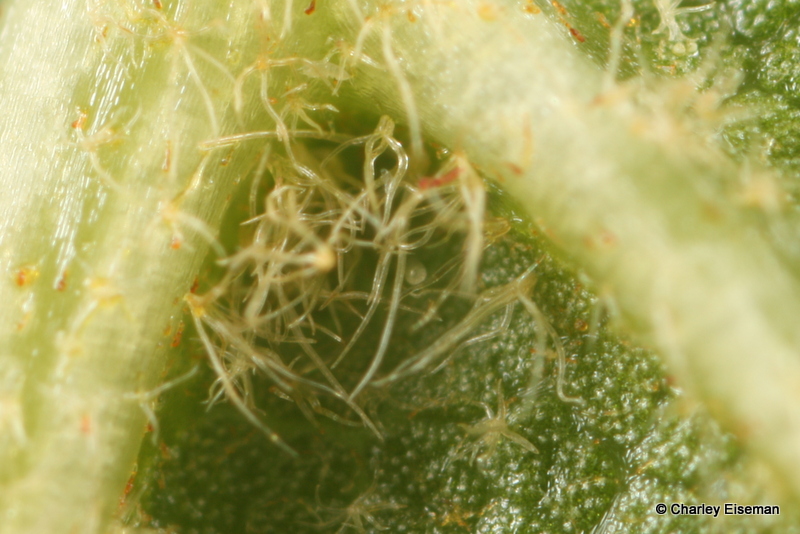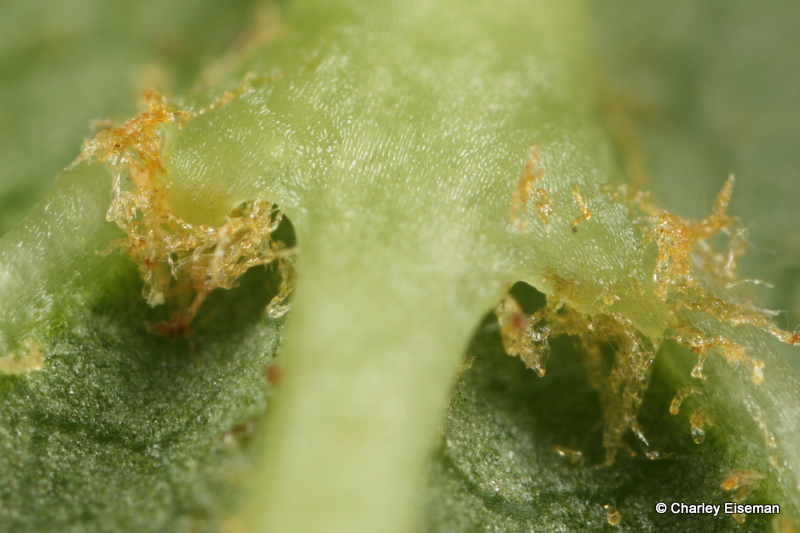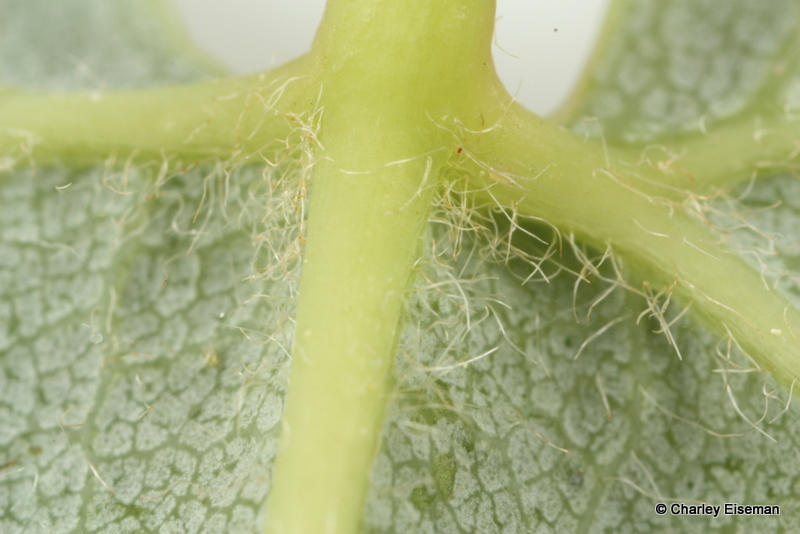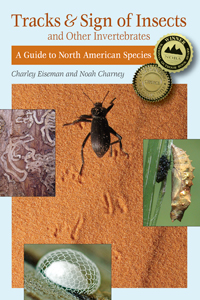You know those hairs that line the basal portion of the midrib on the lower surface of black cherry (Rosaceae: Prunus serotina) leaves?

Or the ones in the vein axils on the lower surface of many other tree leaves, like this black oak (Fagaceae: Quercus velutina)?

It turns out these are Acarodomatia! Which is to say, they are structures that evolved for the purpose of housing mites that benefit these plants, either by preying on tiny herbivores (e.g. other mites) or by feeding on pathogenic fungi. I just heard about this for the first time last night when James Trager accidentally sent me a message on Facebook, which caused me to see a link he’d sent me four years earlier that I’d missed until now. (Tip: if you want me to see something, send me an email; I often miss things on Facebook messenger. If you want to make sure I never hear something, leave me a voicemail.) That link was to this “In Defense of Plants” podcast, which I listened to last night; it features Gussie Maccracken talking about her work with fossils, including this paper that gives evidence of acarodomatia already existing around 75 million years ago. Googling “acarodomatia” turns up lots of other information, including this review paper which says (among other things) that these structures are found in about half of North American tree species. I’m a little annoyed that I spent almost 20 years in school and no one ever mentioned the existence of these things.
So, today I walked around the yard and plucked a few leaves that had acarodomatia on them, including the two pictured above, and had a look at them under the microscope. I didn’t see anything among the hairs of the black cherry leaf, but they provide an extensive hiding place and it would be easy to miss any mites that may have been there. When I looked at the ones in the black oak vein axils, I saw a little colorless mite go scrambling out of the second one I looked at, and the same thing happened with the third—I think they were disturbed by the intense light under the scope. I was unable to relocate them when I trained my camera on them, but I believe the spherical object at the center of this photo is a mite egg:

Leaves of striped maple (Sapindaceae: Acer pensylvanicum), it turns out, have nice cavernous retreats in the vein axils behind these hairs. There are several pairs of these acarodomatia along the length of the midrib.

The red maple (A. rubrum) leaves I looked at just had a single pair of tufts at the base of the midrib. This restricted real estate, it seems, improved my chances of spotting the resident mite. See it?

Okay, it’s pretty subtle, given that it’s extremely tiny (~0.2 mm long) and hiding behind a couple of hairs. Here’s a closer crop:

I got a few other photos of it as it ran around on the leaf veins; they’re certainly not good, but maybe sufficient for an acarologist to tell us approximately what kind of mite it is:

So, as with extrafloral nectaries, these acarodomatia are common structures that are often mentioned in botanical manuals (hairs in the axils of veins noted in this key, for instance), but bafflingly, no one ever bothers to point out what their purpose is.




Nice! There is a relatively large section of Walter and Proctor’s excellent book devoted to these structures:
https://link.springer.com/book/10.1007/978-94-007-7164-2
Thanks!
such news to wake up to!! Thank you! Acarodomatia…. found in 1/2 of tree species… 75 million yr old species… I’ll listen to the podcast, head out with hand lense, time to get a better lense.
Well, cool! I have, indeed, noticed such structures, but not the mites (yet). So why does Black Oak have acarodomatia, but not White Oak? Why don’t all plants have acarodomatia, if they are, in fact, beneficial?
Evolution does not provide things that are useful with forethought. Many things that are beneficial in one species do not evolve in another because of a complex set of interactions at the time those traits might possibly develop. The tree doesn’t “decide” it needs to grow hairs to give mites an advantage. The hairs persist because they provided an advantage. In the case of two oak species, one may not have the genes to produce the hairs or at a time when it had hairs there was no benefit.
Beware of the arrogance that academia instills in those that study nature and it’s complex relationships.
Cool!
there should be a real list of these published rather soon (not by me!) – i don’t think it’ll end up being half of NA trees, but its a pretty extensive list and my friends that were working on it kept finding new examples throughout the work.
Nice, I look forward to seeing it.
The phrase “evolved for the purpose” made me cringe. It is a (too common) misperception that traits develop and persist as if the organism recognizes a need and then decides to grow a great solution. In the course of the evolution of a species genes express many traits and some persist because they give the species as a whole some advantage. Or they persist because the trait is not detrimental enough to cause the species as a whole to decline.
I fully understand that; it was just a concise way of putting it.
Sure. People talk about it this way all the time. Can be misleading.
It becomes very cumbersome to talk about anything if you take pains to ensure that every sentence acknowledges the senseless randomness of the universe. Does the use of the word “function” applied to structures of organisms make you cringe in the same way? It is a pretty common word in evolutionary biology, and really means the same thing as purpose. I seriously doubt any of my readers believe evolution is a Lamarckian process of conscious self-betterment as you’re describing.
Why not substitute “appears to provide a selective advantage” instead of “evolved for the purpose of.” Just as concise and I believe would answer Kathryn’s objections. Other than that, terrific article and photos. Quite amazing. Love the description of the process of discovery.
By the way, Lamarckism is making a come back with all these recent discoveries in epigenetics! Is is not a conscious process, but it is still very interesting.
Natural history is so damn cool…thanks for the revelation!
Very nice information. I have seen the mites and just didn’t know there was a name for the mite house. I enjoy your posts. Always learn something new. Thank you!
This is so cool!!
The mite you photographed is most likely a member of the family Phytoseiidae, the most common family of this type of mite (Mesostigmata or Gamasida) found on leaves. Many phytoseiids are predaceous and these species have received most of the research attention, since they can be important agents of biological control (thus fulfilling their hypothetical coevolutionary role). But many also consume pollen or even puncture leaves and feed on sap. I have observed one species that apparently feeds only on leaf exudates. But they all seem to like hiding in acarodomatia.
Thank you! I did see in the review paper I linked to that some herbivorous mites are specialized domatia inhabitants, but I decided to keep it simple and let people follow the links to become more informed/confused about the subject.
What fun to read! Not to mention that I learned something new from you–again!
Those “hairs” are so familiar–fascinating to learn how some little critter makes good use of them. (And I don’t imply consciousness when I say that, for I very much appreciate your discussion about “purpose” and evolution.) Love your posts, Charlie!
Interesting, Charley. I know them as indumentum, which may be a better word because it does not imply a purpose. Gall midge larvae also hang out in it.
Ray
Thanks for the very interesting info! I’ve always assumed trichomes were a plant defense against herbivores (I’ve seen an aphid impaled on a bean-leaf hair), but never thought about helpful mites hiding out among the fuzz. Good idea, mites!
Someone just found lace bug eggs laid under these hairs on cherry leaves (https://www.inaturalist.org/observations/170350170), so clearly offering shelter indiscriminately to tiny arthropods isn’t purely beneficial to the plant!
Pingback: Ep. 429 – Ancient Leaf Homes Revisited — In Defense of Plants - Walrus Neat